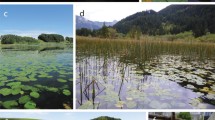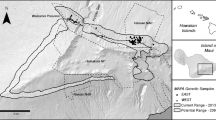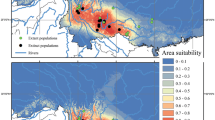Abstract
Habitat fragmentation and invasive alien species contribute to genetic bottlenecks and the threat of extinction of many endemic species of Mauritius, part of the Madagascan and Indian Ocean biodiversity hotspot. The genus Cylindrocline has two species, C. commersonii (critically endangered) and C. lorencei (extinct in the wild). The last living specimens of C. lorencei disappeared in the wild after the recorded collecting of seeds in 1982 by Conservatoire Botanique National de Brest (CBN Brest). Embryo rescue was used as a method to germinate these seeds and the seedlings raised this way were shared by CBN Brest with Royal Botanic Gardens Kew (RBG Kew) as part of an exchange programme in 2001. Mature plants both at CBN Brest and RBG Kew stopped producing viable seeds and this has made the long-term conservation of C. lorencei even more difficult. Seeds of C. commersonii collected from the wild in 2010 have a very low viability while ex situ grown C. commersonii produce non-viable seeds. Molecular studies conducted in C. lorencei using amplified fragment length polymorphisms (AFLP) showed no genetic variability among remaining individuals. Two samples of C. commersonii showed a very small amount of genetic variability. The variability between the two species was well within the limits commonly found within species or between closely related species and the long-term conservation of the genus requires a radical (to a degree) approach to avoid its extinction. The importance of novel approaches for restoration and long-term conservation are discussed.






Similar content being viewed by others
References
Alexander MP (1980) A versatile stain for pollen fungi, yeast and bacteria. Biotech Histochem 55:13–18
Baker K, Lambdon P, Jones E, Pellicer J, Stroud S, Renshaw O, Niissalo M, Corcoran M, Clubbe C, Sarasan V (2014) Rescue, ecology and conservation of a rediscovered island endemic fern (Anogramma ascensionis): ex situ methodologies and a road map for species reintroduction and habitat restoration. Bot J Linn Soc 174:461–477
Bunn E, Turner S, Panaia M, Dixon KW (2007) The contribution of in vitro technology and cryogenic storage to conservation of indigenous plants. Aus J Bot 55:345–355
Caro TM, O’Doherty G (1999) On the use of surrogate species in conservation biology. Cons Biol 13:805–814
Doležel J, Greilhuber J, Suda J (2007) Estimation of nuclear DNA content in plants using flow cytometry. Nat Protoc 2:2233–2244
Doyle JJ, Dickson EE (1987) Preservation of plant samples for DNA restriction endonuclease analysis. Taxon 36:715–722
Fay MF, Thomas VE, Knapp S (2007) Mellissia begoniifolia: Solanaceae. Curt Bot Mag 24:243–250
Fleishman E, Launer AE, Switky KR, Yandell U, Heywood J, Murphy DD (2001) Rules and exceptions in conservation genetics: genetic assessment of the endangered plant Cordylanthus palmatus and its implications for management planning. Biol Conserv 98:45–53
Hansen DM, Muller CB (2009) Reproductive ecology of the endangered enigmatic mauritian endemic Roussea simplex (Rousseaceae). Int J Plant Sci 170:42–52
Hind N, Sánchez M, Magdalena C (2009) Cylindrocline lorencei. Curt Bot Mag 26:120–130
Huenneke LF (1991) Ecological implications of genetic variation in plant populations. In: Falk DA, Holsinger KE (eds) Genetics and conservation of rare plants. Oxford University Press, New York, pp 31–44
IUCN (2014). http://www.iucnredlist.org/about/summary-statistics#Table6b
Kaiser CN, Hansen DM, Muller CB (2008) Habitat structure affects reproductive success of the rare endemic tree Syzygium mamillatum (Myrtaceae) in restored and un-restored sites in Mauritius. Biotropica 40:86–94
Loureiro J, Rodriguez E, Doležel J, Santos C (2007) Two new nuclear isolation buffers for plant DNA flow cytometry: a test with 37 species. Ann Bot 100:875–888
Marriott P, Sarasan V (2010) Novel micropropagation and weaning methods for the integrated conservation of a critically endangered tree species, Medusagyne oppositifolia. In Vitro Cell Dev Pl 46:516–523
Murashige T, Skoog F (1962) A revised medium for rapid growth and bio assays with tobacco tissue cultures. Physiol Plant 15:473–497
Myers N, Mittermeier RA, Mittermeier CG, da Fonseca GAB, Kent J (2000) Biodiversity hotspots for conservation priorities. Nature 403:853–858
Pellicer J, Kelly LJ, Leitch IJ, Zomlefer WB, Fay MF (2014) A universe of dwarfs and giants: genome size and chromosome evolution in the monocot family Melanthiaceae. New Phytol 201:1484–1497
Reed BM, Sarasan V, Kane M, Bunn E, Pence VC (2011) Biodiversity conservation and conservation biotechnology tools. In Vitro Cell Dev Pl 47:1–4
Rowntree JK, Cowan RS, Leggett M, Ramsay MM, Fay MF (2010) Which moss is which? Identification of the threatened moss Orthodontium gracile using molecular and morphological techniques. Conserv Genet 11:1033–1042
Rutty R (2011) Cylindrocline commersonii. In: IUCN 2011. IUCN red list of threatened species. Version 2011.1. http://www.iucnredlist.org. Accessed 11 July 2011
Saghai-Maroof MA, Soliman KM, Jorgensen RA, Allard RW (1984) Ribosomal DNA spacer-length polymorphisms in Barley: mendelian inheritance, chromosomal location, and population dynamics. Proc Natl Acad Sci 81:8014–8018
Sarasan V, Cripps R, Ramsay MM, Atherton C, McMichen M, Prendergast G, Rowntree JK (2006) Conservation in vitro of threatened plants—progress in the past decade. In Vitro Cell Dev Pl 42:206–214
Scott A (1987) A second species of Cylindrocline (Compositate-Inulae). Kew Bull 42:476
Sharma DR, Kaur R, Kumar K (1996) Embryo rescue in plants—a review. Euphytica 89:325–337
Soorae PS (ed) (2010) Global re-introduction perspectives: additional case-studies from around the globe. IUCN/SSC Re-introduction Specialist Group, Abu Dhabi
SPSS Inc. SPSS Base 10.0 for Windows User’s Guide. SPSS Inc., Chicago IL
Strahm W (1996) Conservation of the flora of the Mascarene Islands. Curt Bot Mag 13:228–237
Takao HS, Castilho CC, Seaton PT, Marks TR, Machado-Neto NB (2012) Improved assessment of viability and germination of Cattleya (Orchidaceae) seeds following storage. In Vitro Cell Dev Pl 48:127–136
Thompson JD, Gaudeul M, Debussche M (2010) Conservation value of sites of hybridization in peripheral populations of rare plant species. Conserv Biol 24:236–245
Van der Salm TPM, Van der Toorn CJG, Tencate CHH, Dubois LAM, De Vries DP, Dons HJM (1994) Importance of the iron chelate formula for micropropagation of Rosa hybrida L. ‘Moneyway’. Plant Cell Tiss Org 37:73–77
Vujanovic V, St-Arnaud M, Barabé D, Thibeault G (2000) Viability testing of orchid seed and the promotion of colouration and germination. Ann Bot 86:79–86
Wada S, Reed BM (2011) Standardizing germination protocols for diverse raspberry and blackberry species. Sci Hort 132:42–49
Acknowledgments
The authors thank Caroline Atherton and Poppy Marriott for in vitro technical support, Noelia Alvarez, Carlos Magdalena and Nick Johnson and staff at Ex Situ Service of the CBN Brest for their horticultural support. We also acknowledge the help of Hannah Banks for guidance with pollen staining study and NPCS Mauritius for their support to the project. The authors thank Bruno Bordenave and Claudia Baider for their critical review of the earlier version of the manuscript. Authors also acknowledge the funding received from the Threatened Plants Appeal, RBG Kew.
Author information
Authors and Affiliations
Corresponding author
Additional information
Communicated by M. Capuana.
Rights and permissions
About this article
Cite this article
Sarasan, V., Buord, S., Pellicer, J. et al. Approaches to develop a road map for the long-term conservation of an island endemic genus Cylindrocline . Acta Physiol Plant 38, 10 (2016). https://doi.org/10.1007/s11738-015-2030-5
Received:
Revised:
Accepted:
Published:
DOI: https://doi.org/10.1007/s11738-015-2030-5




